Sensor size and the crop factor
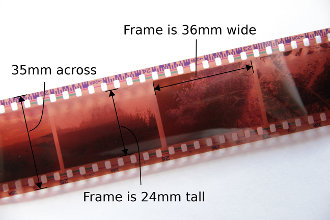 35mm film cameras all captured photos on a strip of film which is 36mm wide. Perhaps it makes you wonder why it is called 35mm film and not 36mm film. The with of the film including the perforated edges used for tracking the film by the camera is actually 35mm across but the frame which is being exposed is 36mm wide and 24mm high. See Illustration 1. Digital Cameras use a sensor instead of a film. When using a Digital camera the sensors come in various sizes. The different sizes are revered to as crop factors. Top of the range Professional cameras are full-frame. A full-frame camera has a 36mm sensor which is the same size as the film. Most Semi professional cameras have a cropped sensor. Which means that the sensor is smaller than the 35mm film, and point and shoot cameras have sensors which are even smaller.
35mm film cameras all captured photos on a strip of film which is 36mm wide. Perhaps it makes you wonder why it is called 35mm film and not 36mm film. The with of the film including the perforated edges used for tracking the film by the camera is actually 35mm across but the frame which is being exposed is 36mm wide and 24mm high. See Illustration 1. Digital Cameras use a sensor instead of a film. When using a Digital camera the sensors come in various sizes. The different sizes are revered to as crop factors. Top of the range Professional cameras are full-frame. A full-frame camera has a 36mm sensor which is the same size as the film. Most Semi professional cameras have a cropped sensor. Which means that the sensor is smaller than the 35mm film, and point and shoot cameras have sensors which are even smaller.
Calculating crop factors
If a camera has a crop factor of 1.5 it means that a full frame measures 1.5 times as much in Height, With and Diagonally. For instance if you have a sensor which is 24mm wide simply divide the full frame with of 36mm by 24mm and you get 1.5 which is the crop factor of that sensor. If on the other hand you knew that you had a crop factor of 1.5 and wanted to know how wide your sensor is simply divide the full frame 36mm by the crop factor of 1.5 and you will get 24mm the with of your sensor. The same goes for sensor height. Divide the full-frame height 24mm by the crop factor of 1.5 and you get 16mm the height of your sensor.
Remember the following formula to determine Crop factors and sensor sizes.
- Full-frame size / Sensor size = Crop factor
- Full-frame size / Crop factor = Sensor size
- Sensor size x Crop factor = Full-frame size
Lets use this formula to determine the crop factor of a Canon sensor which is 22mm wide. Above we can see that Full-frame size "36mm" divided by Sensor size "22mm" equals Crop factor 1.6 truncated to one decimal place.
Crop factor comparison of common sensor dimensions
| Sensor type | Crop factor | With | Height | Diameter | Surface area |
|---|---|---|---|---|---|
| 35mm Film-frame | 1 | 36.0mm | 24.0mm | 43.3mm | 864.0mm˛ |
| Full-frame | 1 | 36.0mm | 24.0mm | 43.3mm | 864.0mm˛ |
| APS-H (Canon) | 1.3 | 27.7mm | 18.5mm | 33.3mm | 511.2mm˛ |
| APS-C (Nikon, Sony, Pentax) | 1.5 | 24.0mm | 26.0mm | 28.8mm | 384.0mm˛ |
| APS-C (Canon) | 1.6 | 22.5mm | 15.0mm | 27.0mm | 337.5mm˛ |
| 4/3 "four thirds" (Olympus, Panasonic) | 2 | 18.0mm | 12.0mm | 21.6mm | 216.0mm˛ |
Sensor size does matter when it comes to control and quality. Expensive Professional DSLR cameras have large full frame sensors. Even Cropped semi professional DSLR Cameras have very large sensors much larger than even the best point and shoot Cameras. The Picture Below demonstrates how different sensor sizes compare against one another. As you can See the 4/3 "four thirds" sensor used in Olympus and Panasonic DSLR Cameras Which have a 2x crop factor. The 4/3 sensor still very large compared to the much smaller point and shoot camera sensors. The 2/3 sensor in the bottom left corner is about as large a sensor you are going to find in a Point and shoot camera. I have put only three common Point and shoot sensor sizes on the illustration, there are many Point and Shoot Sensor sizes that vary slightly from the three common sizes that I included in the picture. All Point and Shoot sensors are small and even the largest ones are tiny compared to any of the DSLR Cameras.
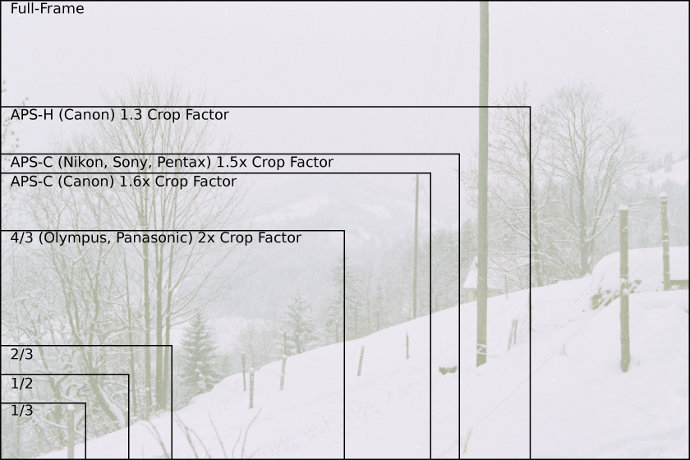
Pixel density and Low light performance
Large sensors are especially useful for low light photography. The reason for this is pixel density. Pixel density revers to how many pixels occupy a given amount of space on the sensor. The same number of pixels on a large sensor is spread over a much larger area. Allowing each individual pixel on the sensor to be physically larger giving it more surface area on to which light from the Lens will fall. For instance many semiprofessional DSLR cameras from Nikon have around 12 megapixels with a 1.5 crop factor. Compare this to a average consumer point and shoot camera which has around 10 megapixels crammed on to a sensor with a crop factor of 4 to 8 which has 9-18 times less surface area. Than the Nikon. In this case the Nikon has a much lower pixel density allowing each pixel to be much larger. The large sensor can gather more light and produce very low noise Photos even with very high ISO settings. Allowing it to Shoot great photos even when less light is present, due to low light or fast shutter speeds.
How The Crop factor effects Focal Length and field of view
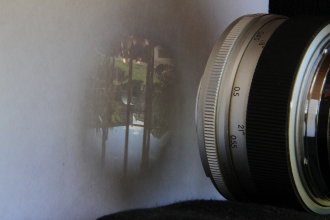
50mm Lens Projecting full circle on to Paper
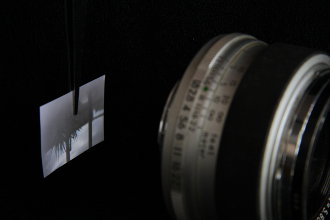
50mm Lens Projecting on to 36x24mm surface
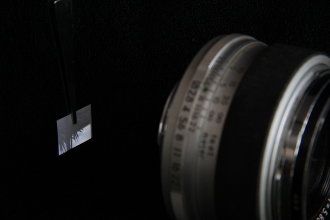
50mm Lens Projecting on to 18x12mm (4/3 cropped size) surface
The Crop factor effects the lenses field of view. back in the old days when every SLR Camera used the same sized 35mm Film all Lenses of a given focal length would produce the same field of view in any SLR Camera. Modern DSLR Cameras come in various sensor sizes and a particular lenses field of view will change according to the Sensor size of the camera the lens is being used on. Lens terminology and descriptions have not changed since the old days, Which is a good thing because it would only make things more confusing. It is however a good Idea for you to learn what field of view a g given focal length produces on different Crop factors. I will try to explain this in a way that you will hopefully easily understand. On the Picture to your right You see a 50mm normal lens projecting a scene on to a piece of white paper. The lens is round so the projection is also round. When attached to a camera the image will be projected on to a Film or a 36mm wide Full-frame sensor. On the second picture I have taken a piece of paper measuring 36 x 24mm The exact same size a full frame sensor would be. This demonstrates exactly what a photograph of this scene would look like if it were taken using a full-frame camera and a 50mm lens. On The Third image I am using the exact same setup except I have replaced the piece op paper with a smaller one. It is the same size as a 4/3 Sensor which measures 18 x 12mm which is a crop factor of two. You can instantly see that part of the image has bean cropped off and the image which is visible looks as if it where viewed trough a telephoto lens.
The first filmstrip image below shows the same scene projected on to sensors of varying sizes while the cropped area is blacked out and shows the sensors size relative to the full frame, demonstrating how it changes the field of view even dough the lens is the same one. The second filmstrip image shows what those photos would look like at full size compared to one another. Once enlarged it clearly shows how the crop factor effects the field of view.
Field of view of varying sensor sizes

| Full-frame | 1.3x | 1.5x | 1.6x | 4/3 | 2/3 | 1/2 | 1/3 |
|---|
Comparison of photos as they would appear at varying sensor sizes

| Full-frame | 1.3x | 1.5x | 1.6x | 4/3 | 2/3 | 1/2 | 1/3 |
|---|
The focal length multiplier
Crop factors are sometimes referred to as focal length multiplier. This term makes a lot sense because when multiplying the focal length by the crop factor it gives you the focal length equivalent to a full frame camera. Lets take the 50mm normal lens and calculate its field of view when used on a sensor with a 2x Crop factor as we have just seen in the pictures. Now multiply the lenses focal length by the crop factor. In this case 50mm x 2 =100mm. This tells us that when using a 2x cropped sensor a 50mm lens behaves exactly like a 100mm telephoto lens would behave on a full frame sensor. This means that on a camera with a 2x crop factor a 50mm lens is a 100mm full frame equivalent. Now lets assume you want to put a lens on your 2x cropped camera with a field of view equivalent to what a 50mm normal lens would be on a full frame camera. In this case divide the focal length of the 50mm normal lens by the crop factor. 50mm / 2 = 25mm. This tells you that attaching a 25mm wide angle lens to a 2x cropped camera becomes a normal lens which behaves the same way a 50mm lens would on a full frame camera. The same calculations can be used for any crop factor. A 50mm lens on a camera with a 1.5x crop factor for instance has the same field of view as a 75mm lens would on a full frame. 50mm x 1.5 = 75mm. And if you wanted to know what the 50mm equivalent would be for a camera with a 1.6 crop factor calculate 50mm / 1.6 = 31.25mm. You probably wont be able to find a 31.25mm lens but 28mm, 30mm, or 35mm are available lenses that will act as normal lens equivalent for a camera with a 1.6 crop factor.
Crop factor lens chart
| Full-frame | 1.3 x | 1.5 x | 1.6 x | 2.0 x "4/3" |
|---|---|---|---|---|
| 8mm | 10.4mm | 12mm | 12.8mm | 16mm |
| 14mm | 18mm | 21mm | 22mm | 28mm |
| 15mm | 19.5mm | 22mm | 24mm | 30mm |
| 16mm | 21mm | 24mm | 26mm | 32mm |
| 18mm | 23mm | 27mm | 29mm | 36mm |
| 20mm | 26mm | 30mm | 32mm | 40mm |
| 21mm | 27mm | 31mm | 34mm | 42mm |
| 25mm | 32mm | 37mm | 40mm | 50mm |
| 28mm | 36mm | 42mm | 45mm | 56mm |
| 30mm | 39mm | 45mm | 48mm | 60mm |
| 31mm | 40mm | 46mm | 50mm | 62mm |
| 35mm | 45mm | 52mm | 56mm | 70mm |
| 43mm | 56mm | 64mm | 69mm | 86mm |
| 45mm | 58mm | 67mm | 72mm | 90mm |
| 50mm | 65mm | 75mm | 80mm | 100mm |
| 55mm | 71mm | 82mm | 88mm | 110mm |
| 60mm | 78mm | 90mm | 96mm | 120mm |
| 70mm | 91mm | 105mm | 112mm | 140mm |
| 77mm | 100mm | 115mm | 123mm | 154mm |
| 85mm | 110mm | 127mm | 136mm | 170mm |
| 100mm | 130mm | 150mm | 160mm | 200mm |
| 105mm | 136mm | 157mm | 168mm | 210mm |
| 135mm | 175mm | 202mm | 216mm | 270mm |
| 150mm | 195mm | 225mm | 240mm | 300mm |
| 180mm | 234mm | 270mm | 288mm | 360mm |
| 200mm | 260mm | 300mm | 320mm | 400mm |
| 300mm | 290mm | 450mm | 480mm | 600mm |
| 400mm | 520mm | 600mm | 640mm | 800mm |
| 500mm | 650mm | 750mm | 800mm | 1000mm |
| 600mm | 780mm | 900mm | 960mm | 1200mm |
| 800mm | 1040mm | 1200mm | 1280mm | 1600mm |
Sensor size and depth of field
The crop factor also effects depth of field. The reason for this is because lenses with a small focal length such as a wide angle lenses have much greater depth of field than lenses with a large focal length, and telephoto lenses which have a large focal length have very narrow depth of field. Even dough you now know how the crop factors changes the field of view. The crop factor does not actually change the way the lens bends light it only changes what is being captured and the rest is cropped off. The effect the focal length has on the depth of field remains the same a small focal length always has greater depth of field, and large focal lengths always have narrow depth of field. Now imagine you have a point shoot camera with 8x crop factor and a 6mm lens. 6Mm is a extremely small focal length with very wide depth of field. On a DSLR Camera a 6mm lens would be an extreme fish-eye but on a point and shoot camera with 8x crop factor (6mm x 8 = 48mm) the 6Mm lens is a 48mm full frame equivalent which means it acts as a normal lens but it has the same depth of field of a 6mm fish-eye.
Halving this great depth of field does not mean that Point and shoot cameras have an advantage over DSLRs. The Small sensor of the point and shoot camera has poor light gathering capabilities compared to the large sensor of the DSLR. With the DSLR you have the ability to have a narrow depth of field which in many cases is desirable and you have the choice of achieving a very wide depth of field by closing the aperture.


